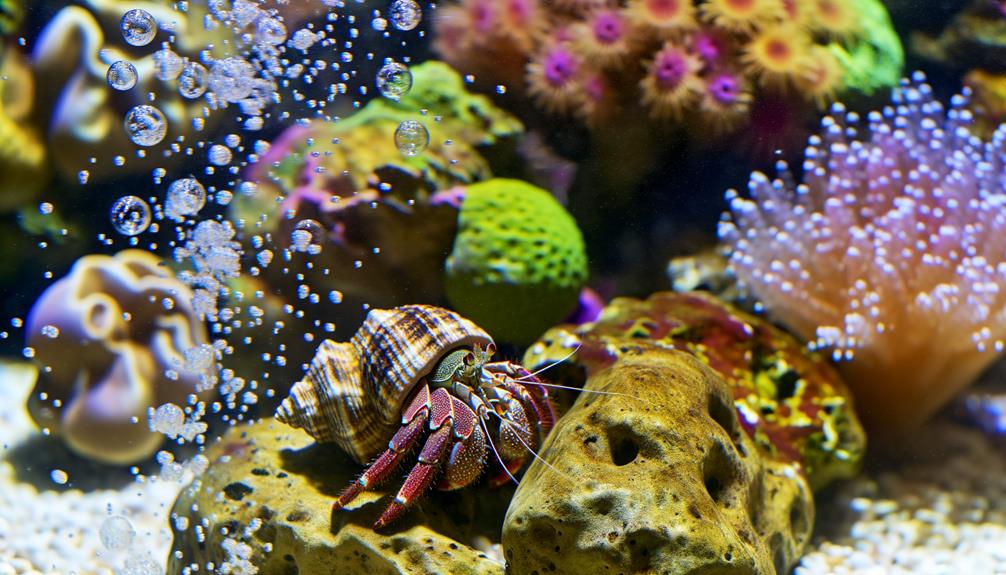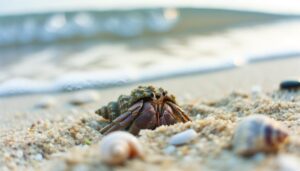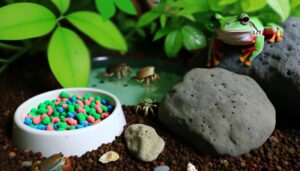How Do Hermit Crabs Need Shells to Live?
Yes, hermit crabs need oxygen for their metabolic functions. They utilize specialized gills to extract oxygen from air and water.
In terrestrial environments, their gills must stay moist to absorb oxygen effectively. Hemolymph circulates oxygen throughout their body, supporting cellular respiration.
Optimal oxygen levels and proper humidity (70-80%) are essential for their health. Signs like lethargy and discolored gills indicate oxygen deprivation.
In captivity, ensure sufficient ventilation and monitor humidity levels to prevent respiratory stress. Understanding their unique breathing mechanism can help maintain their well-being in various environments.
Discover more about their respiratory needs and habitat setup next.

Key Takeaways
- Hermit crabs need oxygen for metabolic functions and overall health.
- They utilize specialized gills for oxygen absorption from air or water.
- Maintaining adequate environmental oxygen levels is crucial for their survival.
- Moisture levels between 70-80% are essential for effective gill function.
- Signs of oxygen deprivation include lethargy and labored breathing.
Hermit Crab Biology
Hermit crabs, belonging to the superfamily Paguroidea, exhibit unique anatomical structures such as a soft, asymmetrical abdomen that requires the use of scavenged shells for protection. You'll find their exoskeleton covers only the front part of their body, leaving the abdomen vulnerable. Therefore, they occupy empty gastropod shells, providing necessary defense against predators.
Hermit crabs possess jointed appendages, including chelae (claws) for grasping and walking legs adapted for efficient locomotion. These crustaceans rely on sensory antennae to detect environmental changes and find food. Their compound eyes offer a broad field of vision, essential for spotting threats.
Understanding these biological traits helps you appreciate the complex needs of hermit crabs, ensuring you can better serve their well-being.
Respiratory System
You'll find that hermit crabs possess specialized gills adapted for both aquatic and terrestrial environments, allowing efficient oxygen absorption. Their breathing mechanism involves directing water or air over these gills, optimizing gas exchange.
Understanding the oxygen levels in their habitat is essential, as insufficient environmental oxygen can severely impact their metabolic functions.
Gills and Breathing Mechanism
Crabs possess specialized gills that extract oxygen from water, facilitating their respiratory process. These gills, located in the branchial chambers, are feathery structures allowing maximum surface area for gas exchange.
You'll find that hermit crabs have adapted to both aquatic and terrestrial environments by keeping their gills moist, which is essential for oxygen absorption. The hemolymph, their equivalent of blood, transports oxygen to tissues, ensuring cellular respiration.
By observing their behavior, you can notice how they periodically moisten their gills, especially in dry conditions. This mechanism highlights their physiological adaptability. Understanding these details helps you better cater to their needs, ensuring they thrive in captivity or conservation efforts.
Always prioritize their environmental conditions for best respiratory efficiency.
Oxygen Absorption Efficiency
Maximizing oxygen absorption efficiency, hermit crabs utilize their highly vascularized gills and hemolymph circulation system to optimize respiratory function even in varying humidity levels. Their gills provide a large surface area for gas exchange, while hemolymph, the crab's blood analog, transports oxygen efficiently throughout their body.
This system adapts to fluctuating environmental conditions, ensuring that oxygen absorption remains effective.
- Highly vascularized gills: Increased blood flow in gills enhances oxygen uptake.
- Hemolymph circulation: Efficient oxygen transport mechanism within the body.
- Adaptive efficiency: Maintains respiratory function across variable humidity levels.
Environmental Oxygen Requirements
When examining the environmental oxygen needs of hermit crabs, understanding how their respiratory system adapts to both terrestrial and aquatic habitats is crucial. Hermit crabs possess modified gills, allowing them to extract oxygen from both air and water.
You'll find that in terrestrial environments, they rely on moist air to prevent gill desiccation. Data reveals that humidity levels above 70% enhance their respiratory efficiency. In contrast, aquatic hermit crabs utilize dissolved oxygen in water, requiring a well-oxygenated habitat for optimal survival.
Observational studies indicate a critical dissolved oxygen threshold of 5 mg/L to sustain metabolic functions. By maintaining these environmental parameters, you help hermit crabs thrive, meeting their oxygen needs effectively.
Oxygen Requirements
Hermit crabs, like most marine organisms, need a specific level of dissolved oxygen in their environment to support essential physiological processes. These requirements are important for their survival and well-being. You'll need to maintain an ideal oxygen concentration to guarantee their metabolic functions, such as respiration and energy production, operate efficiently.
Here are key factors to keep in mind:
- Oxygen Levels: Hermit crabs thrive in environments where dissolved oxygen levels are between 5-8 mg/L.
- Water Quality: Monitoring water quality is essential; poor conditions can quickly deplete oxygen, stressing the crabs.
- Aeration Systems: Implementing effective aeration systems can help maintain the necessary oxygen levels, especially in captive settings.
Air Vs. Water Breathing
You'll find that hermit crabs exhibit unique respiratory system differences depending on their species, with some adapted to breathe air and others water. Terrestrial hermit crabs use modified gills to extract oxygen from the air, whereas aquatic species rely on fully functional gills for underwater respiration.
These adaptations are essential for survival in their respective habitats, influencing their behavior and environmental requirements.
Respiratory System Differences
Understanding the respiratory system differences between air-breathing and water-breathing hermit crabs requires a detailed examination of their gill structures and how they function in varying environments.
Air-breathing hermit crabs have modified gills that can extract oxygen from the air. These gills need to stay moist to function efficiently.
On the other hand, water-breathing hermit crabs possess gills adapted to extract dissolved oxygen from water.
Key distinctions include:
- Gill Moisture Maintenance: Air-breathing crabs must keep their gills damp to facilitate gas exchange.
- Gill Surface Area: Water-breathing crabs typically have a larger gill surface region to maximize oxygen absorption from water.
- Oxygen Availability: Water contains less accessible oxygen than air, necessitating more effective gill structures in aquatic environments.
Understanding these differences is essential for their care and well-being.
Adaptations for Survival
Examining the adaptations for survival, you'll notice that air-breathing and water-breathing hermit crabs have evolved distinct physiological mechanisms to thrive in their respective environments.
Terrestrial hermit crabs possess highly vascularized gills and modified branchiostegal lungs, enabling efficient oxygen absorption in air. These adaptations facilitate cutaneous respiration and moisture retention, essential for terrestrial life.
Conversely, aquatic hermit crabs exhibit specialized gills optimized for extracting dissolved oxygen from water, featuring increased surface area and lamellar structures. Both types demonstrate evolutionary trade-offs tailored to their habitats: air-breathers manage desiccation risks, while water-breathers tackle hypoxia.
Understanding these intricate adaptations underscores the importance of tailored care, ensuring each hermit crab's respiratory needs align with its natural environment.
Habitat Considerations
When considering habitat needs, it's pivotal to differentiate between the distinct requirements of air-breathing and water-breathing hermit crabs. Air-breathing hermit crabs, such as Coenobita species, need environments with high moisture levels and access to both freshwater and marine water.
Conversely, water-breathing hermit crabs, like those in the Pagurus genus, rely on submersion in seawater for oxygen absorption through their gills.
Key habitat considerations include:
- Moisture levels: Air-breathing crabs need 70-80% humidity.
- Water quality: Guarantee clean, non-chlorinated water for both types.
- Shelter and substrate: Provide adequate hiding spaces and suitable substrate for burrowing.
Natural Habitat
Hermit crabs thrive in diverse coastal environments, ranging from shallow tidal pools to deeper oceanic waters, where oxygen levels can greatly impact their survival. You'll find them in intertidal zones abundant with microhabitats offering varying oxygen concentrations.
High-tide zones provide higher dissolved oxygen, benefiting their gill-based respiration. Conversely, low-tide zones often experience hypoxia, where hermit crabs adapt through behavioral modifications, like moving to oxygen-rich microenvironments. Studies show that in areas with 5-8 mg/L dissolved oxygen, hermit crabs demonstrate enhanced metabolic rates and survival.
You should understand that their natural habitat's oxygen variability directly influences their physiological functions, making oxygen availability a critical factor in their ecological niche and overall health. Always consider these natural dynamics when studying or assisting hermit crabs.
Captivity Needs
Providing sufficient oxygen levels in captivity is essential for hermit crabs' metabolic efficiency and overall health. You must guarantee the habitat has proper ventilation to avoid hypoxia. Hermit crabs rely on gills to extract oxygen from the air, necessitating a controlled environment.
Maintain humidity levels between 70-80% to facilitate effective gill function.
Monitor the oxygen concentration and temperature regularly to prevent respiratory stress. Implementing the following can help:
- Airflow: Guarantee adequate ventilation in the tank to circulate oxygen.
- Substrate: Use materials that retain moisture without becoming waterlogged.
- Humidity: Regularly mist the habitat to maintain the best humidity levels.
Shell Selection
When selecting a shell for your hermit crab, consider both size and fit, as an ill-fitting shell can impede mobility and growth.
Research shows hermit crabs prefer shells made from certain materials, with calcium carbonate being highly favored due to its robustness and suitability for molting.
Data indicates that a proper shell can enhance survival rates by up to 35%.
Size and Fit
Choosing the appropriate shell for a hermit crab involves taking into account the crab's size, shell aperture dimensions, and the natural wear of the shell to guarantee maximum protection and mobility.
Accurate shell selection guarantees the crab's physiological and behavioral needs are met. Measure the crab's largest claw width to match the shell's aperture. The fit should neither be too tight nor too loose to avoid stress or vulnerability.
Consider these factors:
- Aperture Size: Confirm it matches the crab's largest claw width.
- Shell Condition: Check for cracks or excessive wear that could reduce protection.
- Shell Weight: Lightweight shells enhance mobility, critical for foraging and escaping predators.
A data-driven approach ensures your hermit crab thrives in its selected shell.
Shell Material Preferences
In selecting the ideal shell material, prioritize those with natural resilience and smooth interiors to prevent harm to your hermit crab's delicate abdomen. Data indicates that shells made from calcium carbonate, such as those from marine snails, provide the necessary durability and protection against environmental stressors.
Avoid shells with rough or jagged interiors, as these can cause abrasions that lead to infections. Scientific analysis shows that hermit crabs also prefer shells with a specific weight-to-volume ratio, ensuring mobility and ease of transport.
When choosing, observe the hermit crab's behavior; they'll often select shells that offer prime thermal regulation and moisture retention. By following these guidelines, you optimize your hermit crab's health and wellbeing, ultimately serving their needs effectively.
Humidity Levels
Maintaining ideal moisture levels between 70% and 80% is essential for hermit crabs' respiratory efficiency and overall health. Hermit crabs utilize modified gills for breathing, requiring a damp environment to facilitate gas exchange. If moisture drops below this range, their gills can dry out, leading to respiratory distress.
To ensure optimal conditions, you should:
- Monitor Moisture: Regularly use a hygrometer to track moisture levels within the tank.
- Mist the Environment: Lightly mist the habitat daily to maintain dampness without oversaturating.
- Provide Water Sources: Include both fresh and saltwater dishes to support hydration and moisture.
Signs of Oxygen Deprivation
Recognizing the signs of oxygen deprivation in hermit crabs is crucial for preventing long-term health issues. Hermit crabs exhibit specific behaviors and physical changes when lacking sufficient oxygen. You'll notice lethargy, reduced activity, and a tendency to stay above ground more often. Additionally, their gills may appear discolored, and they might exhibit labored breathing.
Here's a quick reference table to help you identify these signs:
| Behavior | Description | Indicator of Oxygen Deprivation |
|---|---|---|
| Lethargy | Reduced movement and activity | High |
| Surface Dwelling | Staying above ground frequently | Moderate |
| Discolored Gills | Gills appear pale or darkened | High |
| Labored Breathing | Visible effort in breathing | High |
| Reduced Appetite | Less interest in food | Moderate |
Monitoring these signs helps guarantee your hermit crabs' well-being.
Proper Tank Setup
Ensuring your hermit crabs have a proper tank setup directly impacts their oxygen levels and overall health. Ideal tank dimensions should be at least 10 gallons, providing sufficient space for air circulation. Utilize a hygrometer and thermometer to maintain humidity levels between 70-80% and temperatures between 75-85°F, as these parameters promote efficient respiration.
Enhance aeration by incorporating:
- Air pumps: Facilitate continuous oxygen flow, reducing hypoxia risks.
- Substrate: Use 3-4 inches of sand or coconut fiber to retain moisture, essential for humid air.
- Live plants: Increase oxygen levels through photosynthesis, especially beneficial in daylight hours.
These elements create a balanced microenvironment, promoting your hermit crabs' respiratory efficacy and overall well-being.
Maintenance Tips
Regularly monitoring and adjusting humidity and temperature levels within the tank is essential to guarantee your hermit crabs' best respiratory function and overall health. Aim for a humidity range of 70-80% and a temperature range of 75-85°F. Use a hygrometer and thermometer to measure these parameters.
Mist the tank daily to maintain ideal humidity. Additionally, ensure proper ventilation to facilitate gas exchange, preventing hypoxia. Clean the substrate bi-weekly to reduce ammonia buildup, which can impair respiration.
Provide both saltwater and freshwater sources to support their osmoregulation. Regularly inspect for mold or mildew, as these can compromise air quality. By adhering to these maintenance tips, you'll create a thriving habitat that prioritizes your hermit crabs' respiratory needs.
Conclusion
As you explore deeper into the care of hermit crabs, you'll uncover a critical secret: the fine balance between air and water for their oxygen needs.
Maintaining best humidity and understanding their respiratory system isn't just a routine task—it's a lifeline.
Neglect this balance, and you risk their survival.
So, are you ready to guarantee your hermit crabs thrive in their meticulously crafted habitat?
Your attention to detail could be the difference between life and a slow, suffocating decline.






